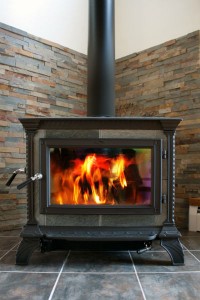As you consider a new fireplace or heating stove, you may want to consider how your new appliance would work to provide heat during a power outage. Power outages are downright inconvenient, but a power outage during cold weather can be dangerous or, if you try to heat your home with the wrong type of heater, even deadly. If you choose the right fireplace or stove, you and your family could be safe and warm in the event of a long-term power outage.
Heating stoves and fireplaces in a power outage
Heating stoves, regardless of the fuel source, can keep you warm even when the power is out. Most stoves do use electric blowers to pump out as much heat as possible, but they will continue to emit heat even without the blowers during a power outage. One of the biggest advantages of a stove during a power outage is they provide 360 degree of heat because all sides of the stove are open to the room, as compared with a fireplace that is recessed into the wall. Because most heating stoves are vented to the outside, they are one of the safest ways to heat your home during a power outage, because they’re not allowing dangerous gases to build up inside your home.
If a traditional, vented stove isn’t a possibility in your home because of where you would like to place the stove, vent-free gas stoves are another option. They, too, will continue to heat your room during a power outage. There is a caution with vent-free stoves, however: It’s generally recommended that they are not burned for more than four hours at one time, though most models do contain oxygen sensors that will shut the stove down if the oxygen levels in the room drop too low. For this reason, they are not permitted in some states. Check with your local fireplace shop for more information.
Open-hearth, wood-burning fireplaces often are criticized as the least efficient home-heating method, but they can be a valuable source of heat for your home during a power outage. While some modern fireplaces do use electric blowers to distribute heat back into your home, as with stoves, the fireplace will continue to provide some heat to your home when the blowers are not operational.
Fueling your fireplace or stove during a power outage
Regardless of what type of fuel your fireplace takes — other than electricity — you should be well-equipped to power your fireplace or stove during a power outage. As long as you keep stacks of wood or extra bags of pellets on hand, your wood or gravity-fed pellet fireplace or stove will be ready to warm your home during a power outage. Natural gas will usually keep running during a power outage, and many models of gas stoves and fireplaces have battery back-ups for their ignition during a power outage.
Safe heating during a power outage
To keep your family warm and safe during a power outage, there are several things to keep in mind. Never leave your fireplace or stove unattended, and make sure any flammable blankets or other materials are kept far away from the fireplace or stove. Make sure your home is equipped with carbon monoxide detectors and fire extinguishers.
With the right preparation, your stove or fireplace can be ready to keep your family warm in an emergency. New Buck Chimney Services is here to help you stay safe this winter. Call or schedule an appointment for more information on fireplace, chimney or safety questions.

